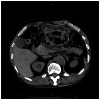Small Intestinal Ulceration in Two Recurrence-Free Young Patients at 10 Years Postoperatively
- PMID: 40799892
- PMCID: PMC12343158
- DOI: 10.7759/cureus.87856
Small Intestinal Ulceration in Two Recurrence-Free Young Patients at 10 Years Postoperatively
Abstract
Small intestinal ulcers are occasionally observed in daily medical practice, and although diagnostic abilities have improved in recent years and the disease pathogenesis has been elucidated, recurrence remains common, requiring proper therapeutic intervention. Herein, we report two cases of small intestine ulceration in young patients who did not experience recurrence for a long period of time after appropriate treatment at disease onset. Case 1 was of a 34-year-old woman who had been taking diclofenac sodium. She was diagnosed with intestinal obstruction through abdominal computed tomography (CT). The patient underwent partial resection of the obstructed ileum. Histopathological examination revealed fibrosis in the submucosa, leading to a diagnosis of stenosis secondary to drug-induced small intestinal ulceration caused by nonsteroidal anti-inflammatory drugs (NSAIDs). Postoperatively, the NSAIDs were changed to a selective COX-2 inhibitor (celecoxib). Case 2 was of a 33-year-old man who underwent emergency surgery after an abdominal CT revealed free air. A perforation was found in the small intestine, and the area was resected. Histopathological examination revealed only nonspecific inflammatory findings, leading to a diagnosis of perforation due to a simple small intestinal ulcer. No recurrence was observed in 10 years in both cases. Thus, appropriate management of simple, nonmalignant small intestinal ulcers at initial presentation could be the only treatment needed, with long postoperative recurrence-free periods. These cases demonstrated that proper management of simple, nonmalignant small intestinal ulcers at the initial presentation can be the only treatment needed for long postoperative recurrence-free periods. With an aging society and improved diagnostic capabilities, small intestinal ulcers may become more common in the future. Therefore, the possibility of small intestinal ulceration should be considered when diagnosing ulcerative lesions of the gastrointestinal tract, such as acute abdomen.
Keywords: abdominal computed tomography; fibrosis; intestinal obstruction; small intestine; stenosis; ulcers.
Copyright © 2025, Masuda et al.
Conflict of interest statement
Human subjects: Informed consent for treatment and open access publication was obtained or waived by all participants in this study. Conflicts of interest: In compliance with the ICMJE uniform disclosure form, all authors declare the following: Payment/services info: All authors have declared that no financial support was received from any organization for the submitted work. Financial relationships: All authors have declared that they have no financial relationships at present or within the previous three years with any organizations that might have an interest in the submitted work. Other relationships: All authors have declared that there are no other relationships or activities that could appear to have influenced the submitted work.
Figures






Similar articles
-
Prescription of Controlled Substances: Benefits and Risks.2025 Jul 6. In: StatPearls [Internet]. Treasure Island (FL): StatPearls Publishing; 2025 Jan–. 2025 Jul 6. In: StatPearls [Internet]. Treasure Island (FL): StatPearls Publishing; 2025 Jan–. PMID: 30726003 Free Books & Documents.
-
Tolerability of selective cyclooxygenase 2 inhibitors used for the treatment of rheumatological manifestations of inflammatory bowel disease.Cochrane Database Syst Rev. 2014 Oct 23;2014(10):CD007744. doi: 10.1002/14651858.CD007744.pub2. Cochrane Database Syst Rev. 2014. PMID: 25340915 Free PMC article.
-
Automated devices for identifying peripheral arterial disease in people with leg ulceration: an evidence synthesis and cost-effectiveness analysis.Health Technol Assess. 2024 Aug;28(37):1-158. doi: 10.3310/TWCG3912. Health Technol Assess. 2024. PMID: 39186036 Free PMC article.
-
The Black Book of Psychotropic Dosing and Monitoring.Psychopharmacol Bull. 2024 Jul 8;54(3):8-59. Psychopharmacol Bull. 2024. PMID: 38993656 Free PMC article. Review.
-
Systemic pharmacological treatments for chronic plaque psoriasis: a network meta-analysis.Cochrane Database Syst Rev. 2017 Dec 22;12(12):CD011535. doi: 10.1002/14651858.CD011535.pub2. Cochrane Database Syst Rev. 2017. Update in: Cochrane Database Syst Rev. 2020 Jan 9;1:CD011535. doi: 10.1002/14651858.CD011535.pub3. PMID: 29271481 Free PMC article. Updated.
References
-
- [A case of small intestinal ulcer caused by non-steroidal anti-inflammatory drugs patch] Aoyama Y, Takahashi S, Inaba T, Izumikawa K, Nakamura S. Nihon Shokakibyo Gakkai Zasshi. 2019;116:145–152. - PubMed
-
- [Pathogenesis of nonsteroidal anti-inflammatory drug (NSAID)-induced small intestinal ulceration: aggravation of NSAID-provoked small intestinal ulceration in adjuvant-induced arthritic rats] Kato S, Amagase K, Takeuchi K. Nihon Yakurigaku Zasshi. 2009;133:203–205. - PubMed
-
- Multiple colon ulcers with typical small intestinal lesions induced by non-steroidal anti-inflammatory drugs. Akashi M, Ando T, Hamashima T, et al. Intern Med. 2015;54:1995–1999. - PubMed
-
- Endoscopic features of chronic nonspecific multiple ulcers of the small intestine: comparison with nonsteroidal anti-inflammatory drug-induced enteropathy. Matsumoto T, Nakamura S, Esaki M, Yada S, Koga H, Yao T, Iida M. Dig Dis Sci. 2006;51:1357–1363. - PubMed
Publication types
LinkOut - more resources
Full Text Sources
Research Materials
